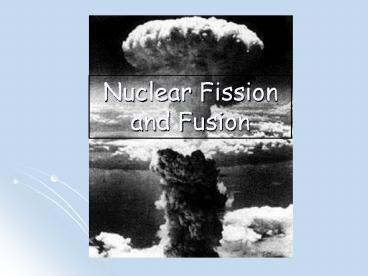Nuclear Fission and Fusion - PowerPoint PPT Presentation
1 / 27
Title:
Nuclear Fission and Fusion
Description:
Nuclear Fission and Fusion Nuclear power Power can be obtained two ways. Fission Splitting atoms Get energy if the nucleus is big. The smaller ones are more stable. – PowerPoint PPT presentation
Number of Views:1897
Avg rating:5.0/5.0
Title: Nuclear Fission and Fusion
1
Nuclear Fission and Fusion
2
Nuclear power
- Power can be obtained two ways.
- Fission Splitting atoms
- Get energy if the nucleus is big.
- The smaller ones are more stable.
- What we do in nuclear reactors.
- Fusion Joining atoms
- Get energy if the nuclei are small.
- The larger one is more stable.
- This is how the sun works.
3
Nuclear Fission
- Fission is the splitting of atoms
- These are usually very large, so that they are
not as stable - Fission chain has three general steps
- 1. Initiation. Reaction of a single atom
starts the chain (e.g., 235U neutron) - 2. Propagation. 236U fission releases neutrons
that initiate other fissions - 3. Termination.
4
Nuclear Fission
- A very heavy nucleus splits into more stable
nuclei of intermediate mass. - The mass of the products is less than the mass of
the reactants. - Missing mass is converted to energy
5
Fission
- In 1939 Lise Meitner an Austrian chemist in
Sweden also working on neutron bombardment
experiments proposed that the barium formed as a
result of the neutrons splitting the Uranium
atoms into two fragments - She proposed the term fission to describe this
process because of its similarity to the
reproductive fission of a biological cell
6
Fission of 238U
7
Chain Reaction
8
Uranium Isotopes
- Naturally occurring Uranium contains two major
isotopes - Uranium-238 (99.3)
- Uranium-235 (0.7)
- As it turns out the only isotope of Uranium that
undergoes fission is Uranium-235
9
235U Fission
- 23592U 10n ? 23692U
- and 10-14 seconds later...
- 23692U ? 9236Kr 14156Ba 3 10n ENERGY
- 50 possible sets of fission products (sum of
atomic numbers 92) - 3 neutrons released for ONE 23592U
- each neutron can split another 23592U
- CHAIN REACTION POSSIBLE
- If amount of 23592U is sufficient (CRITICAL MASS)
then the number of neutrons generated is high
enough to result in a nuclear explosion )
10
(No Transcript)
11
(No Transcript)
12
(No Transcript)
13
(No Transcript)
14
(No Transcript)
15
(No Transcript)
16
Where does all this energy come from?
17
E mc2E Energy (joules)m mass (kg)c
speed of light 3 x 108 m/s
18
Nuclear Fission POWER
- Currently about 103 nuclear power plants in the
U.S. and about 435 worldwide. - 17 of the worlds energy comes from nuclear.
19
(No Transcript)
20
Fusion
- Light-mass nuclei combine to form a heavier, more
stable nucleus. - More energetic than fission reactions
- Source of energy for the H-bomb
- Origin of the elements
21
FUSION
411H ? 42He 2 ? ? energy
22
The most destructive force on the planet
H-bombs 1000s of times more powerful than A-bombs
23
Fusion of Helium atoms42He 42He ? ? energy
24
Fusion of Helium atoms 42He 42He ? 84Be
energy
25
Practice42He 84Be ? ? energy42He ? ?
168O energy42He 168O ? ? energy42He
2010Ne ? ? energy
26
Answers42He 84Be ? 126C energy42He 126C
? 168O energy42He 168O ? 2010Ne
energy42He 2010Ne ? 2412Mg energy
27
Binding Energy of Nuclei































